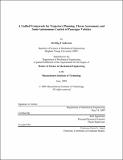| dc.contributor.advisor | Karl Iagnemma. | en_US |
| dc.contributor.author | Anderson, Sterling J., Ph. D. Massachusetts Institute of Technology | en_US |
| dc.contributor.other | Massachusetts Institute of Technology. Dept. of Mechanical Engineering. | en_US |
| dc.date.accessioned | 2009-12-10T16:59:54Z | |
| dc.date.available | 2009-12-10T16:59:54Z | |
| dc.date.copyright | 2009 | en_US |
| dc.date.issued | 2009 | en_US |
| dc.identifier.uri | http://hdl.handle.net/1721.1/49876 | |
| dc.description | Thesis (S.M.)--Massachusetts Institute of Technology, Dept. of Mechanical Engineering, 2009. | en_US |
| dc.description | This electronic version was submitted by the student author. The certified thesis is available in the Institute Archives and Special Collections. | en_US |
| dc.description | Includes bibliographical references (p. 111-117). | en_US |
| dc.description.abstract | This thesis describes the design of an active safety framework that performs trajectory planning, threat assessment, and semi-autonomous control of passenger vehicles in hazard avoidance scenarios. The vehicle navigation task is formulated as a constrained optimal control problem with the constraints bounding a navigable region of the environment derived from forward -looking sensors. First, a constrained model predictive controller is designed to iteratively plan an optimal or "best-case" vehicle trajectory through the constrained corridor. This "best-case" scenario is then used to establish the minimum threat posed to the vehicle given its current state and driver inputs. Based on this threat assessment, the level of controller intervention required to prevent departure from the navigable corridor is calculated and driver/controller inputs are scaled accordingly. This approach minimizes controller intervention while ensuring that the vehicle does not depart from a navigable corridor. It also provides a unified architecture into which various vehicle models, actuation modes, trajectory-planning objectives, driver preferences, and levels of autonomy can be seamlessly integrated without changing the underlying controller structure. Simulated and experimental results are presented to demonstrate the framework's ability to incorporate multiple threat metrics and configurable intervention laws while sharing control with a human driver. Various maneuvers are tested, including lane-keeping, hazard avoidance, and multiple hazard avoidance and show that this framework capable of maintaining vehicle stability while semi-autonomously avoiding road hazards and conceding significant control to the human driver. | en_US |
| dc.description.statementofresponsibility | by Sterling J. Anderson. | en_US |
| dc.format.extent | 126 p. | en_US |
| dc.language.iso | eng | en_US |
| dc.publisher | Massachusetts Institute of Technology | en_US |
| dc.rights | M.I.T. theses are protected by
copyright. They may be viewed from this source for any purpose, but
reproduction or distribution in any format is prohibited without written
permission. See provided URL for inquiries about permission. | en_US |
| dc.rights.uri | http://dspace.mit.edu/handle/1721.1/7582 | en_US |
| dc.subject | Mechanical Engineering. | en_US |
| dc.title | A unified framework for trajectory planning, threat assessment, and semi-autonomous control of passenger vehicles | en_US |
| dc.type | Thesis | en_US |
| dc.description.degree | S.M. | en_US |
| dc.contributor.department | Massachusetts Institute of Technology. Department of Mechanical Engineering | |
| dc.identifier.oclc | 464227762 | en_US |
